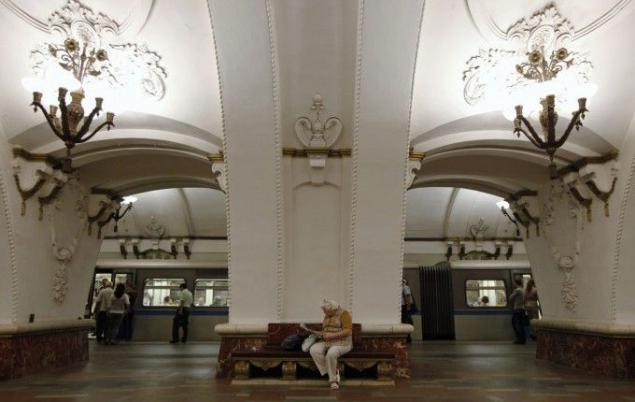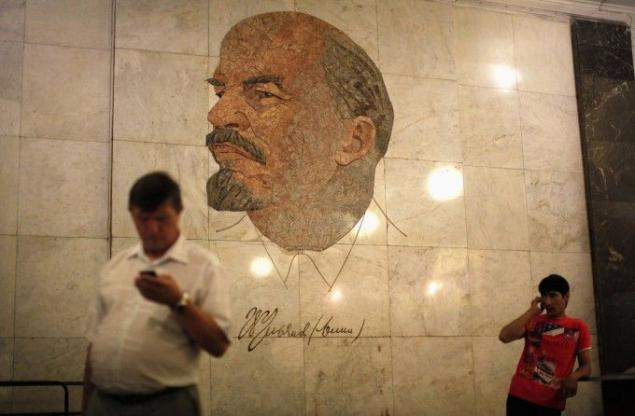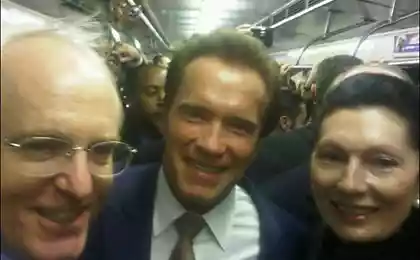2961
Foreign tourist in Moscow metro
Foreign tourist visited the Moscow metro and wanted to share with you the best impressions on the subway.
Girl writes: Sign in Moscow metro - it's like that to take a step back in time and find yourself in an amazing museum of architecture and history.

Ceiling Nevsky Prospect. Moscow, August 17, 2013. Photo: REUTERS / Lucy Nicholson

Girls at the metro station Turgenev. Moscow, August 16, 2013. Photo: REUTERS / Lucy Nicholson

Opened in 1935, the Moscow subway - is extravagant design gallery communist, flaunt samples of Soviet art, popular in those years, art deco style, monumental statues, magnificent chandeliers, marble columns and mosaic ceilings.
Entrance to the metro station Arbat. Moscow, August 17, 2013. Photo: REUTERS / Lucy Nicholson

Built under Stalin best Soviet artists and architects, the Moscow metro transports 9.7 million people a day - more than London and New York subway put together. Price single fare - 30 rubles (about $ 1). When we arrived in Moscow to cover the World Championships in Athletics IAAF us together with other documents issued passes to the subway. The first day I took advantage of this mode of transport back to the hotel with a group of photographers from the agency Reuters after we missed the last bus service.
On Nevsky Prospect. Moscow, August 17, 2013. Photo: REUTERS / Lucy Nicholson

Couple kissing in front of stained glass in the subway station Novoslobodskaya. Moscow, August 17, 2013. Photo: REUTERS / Lucy Nicholson

We were amazed by the architecture and continued to move further in Moscow is the only way to capture the image and self subway and passengers kissing couples, and was late pyanchuzhek ordinary Muscovites, for some reason, tried his best to avoid direct eye contact.
At the metro station Novoslobodskaya. Moscow, August 17, 2013. Photo: REUTERS / Lucy Nicholson

Train raced with incredible noise, so talk in the car was quite difficult. But the speed and they had unbelievable. If we missed the train, we rarely had to wait more than a minute the next. And when the train approached the station, should hurry to avoid the moment of closing the door in front of the nose of the careless. I made that mistake once, and heavy doors, bounced off my forearm, immediately shut aggressively.
Woman smokes in a subway station Riga. Moscow, August 15, 2013. Photo: REUTERS / Lucy Nicholson
On Prospekt Mira Metro Station. Moscow, August 14, 2013. Photo: REUTERS / Lucy Nicholson

On Prospekt Mira Metro Station. Moscow, August 14, 2013. Photo: REUTERS / Lucy Nicholson

Locals say that we were lucky this time of year in the metro is relatively deserted - August-month, many Muscovites to leave. A Russian photographer told me that in the post-Soviet times, people still tend to mistrust and wary of attempts to photograph them.
On Prospekt Mira Metro Station. Moscow, August 16, 2013. Photo: REUTERS / Lucy Nicholson

But with our backpacks decorated with the emblems of the World Championship in Athletics, we obviously looked like tourists, so that no one is paying attention. Some companions smiled at us, a couple of kids, borrowing the iPhone in the mother, tried to take a picture of us in return. Only the driver somehow reacted angrily to a deafening howl of sirens when I bring him his camera. This howling loudly rolled down a deserted station.
Mosaic depicting Vladimir Lenin at the metro station Komsomolskaya. Moscow, August 14, 2013. Photo: REUTERS / Lucy Nicholson

Theft in the metro still happen quite often, despite the ubiquity of surveillance cameras and the police, so we always stick together, group, fearing for our photographic equipment.
Girl t nose bronze sculpture happy dog at the metro station Revolution Square. Moscow, August 14, 2013. Photo: REUTERS / Lucy Nicholson

One of the most beautiful subway stations - Mayakovsky, who is famous for its ceiling with 34 mosaics depicting "24 hours in the Land of the Soviets." During the Second World War, the station was used as a command post anti-aircraft regiment of Moscow.
Reading girl on the subway station Net ponds. Moscow, August 16, 2013. Photo: REUTERS / Lucy Nicholson

At the station, Plaza of the Revolution, when the crowds leave the cars, a lot of hands stretched to rub the nose of the bronze dogs: they say it brings good luck. Dog's nose is polished to a shine and stands in the shadows station among 76 bronze sculptures in full size.
Mosaic depicting Vladimir Lenin at the metro station Biblioteca. Vladimir Lenin. Moscow, August 13, 2013. Photo: REUTERS / Lucy Nicholson

During the Cold War the station Arbat line with their slow wooden escalators have been deepened to serve as a refuge in case of nuclear attack. Rumor has it that in 1950, Stalin ordered a top secret line was excavated, which was deeper than the rest of the metro line and connects the airport and the Kremlin complex protective bunkers.
On Nevsky Prospect. Moscow, August 17, 2013. Photo: REUTERS / Lucy Nicholson

Portraits of Lenin still everywhere. Stalin was removed in 1956, three years after his death. The program of de-Stalinization of Nikita Khrushchev was aimed at to bring to "no" reference dictator responsible for the deaths of millions of Soviet citizens as a result of forced collectivization, deportation of ethnic groups, the Gulag and party purges. Ceiling panel at the station Belarus, which depicts three women carrying a hammer and sickle in a wreath with the letters CCCP, initially portrayed women are touching the bust of Stalin.
On the Belorusskaya metro station. Moscow, August 17, 2013. Photo: REUTERS / Lucy Nicholson

Only recently, under Putin, more favorable reviews about Stalin began to be heard again in the context of the patriotic tradition of the Second World War. After the reconstruction of the Kursk station in 2009, many were surprised by the inscription that includes the original text of the Soviet anthem: "We grew Stalin allegiance to the people, to work and to the exploits inspired us." In the corner of Red Square stands a beautiful Kazan Cathedral, which was rebuilt in 1993 after the fall of communism. This cathedral was destroyed by Stalin.
In a country whose recent history is so rich with violence, wars and revolutions, there is a fine line between renovation and updating of its political overtones rich architectural heritage. "Who controls the past controls the future. Who controls the present controls the past "- so said in the novel" 1984 "by George Orwell.
Source: aleks1780.livejournal.com
Girl writes: Sign in Moscow metro - it's like that to take a step back in time and find yourself in an amazing museum of architecture and history.

Ceiling Nevsky Prospect. Moscow, August 17, 2013. Photo: REUTERS / Lucy Nicholson

Girls at the metro station Turgenev. Moscow, August 16, 2013. Photo: REUTERS / Lucy Nicholson

Opened in 1935, the Moscow subway - is extravagant design gallery communist, flaunt samples of Soviet art, popular in those years, art deco style, monumental statues, magnificent chandeliers, marble columns and mosaic ceilings.
Entrance to the metro station Arbat. Moscow, August 17, 2013. Photo: REUTERS / Lucy Nicholson

Built under Stalin best Soviet artists and architects, the Moscow metro transports 9.7 million people a day - more than London and New York subway put together. Price single fare - 30 rubles (about $ 1). When we arrived in Moscow to cover the World Championships in Athletics IAAF us together with other documents issued passes to the subway. The first day I took advantage of this mode of transport back to the hotel with a group of photographers from the agency Reuters after we missed the last bus service.
On Nevsky Prospect. Moscow, August 17, 2013. Photo: REUTERS / Lucy Nicholson

Couple kissing in front of stained glass in the subway station Novoslobodskaya. Moscow, August 17, 2013. Photo: REUTERS / Lucy Nicholson

We were amazed by the architecture and continued to move further in Moscow is the only way to capture the image and self subway and passengers kissing couples, and was late pyanchuzhek ordinary Muscovites, for some reason, tried his best to avoid direct eye contact.
At the metro station Novoslobodskaya. Moscow, August 17, 2013. Photo: REUTERS / Lucy Nicholson

Train raced with incredible noise, so talk in the car was quite difficult. But the speed and they had unbelievable. If we missed the train, we rarely had to wait more than a minute the next. And when the train approached the station, should hurry to avoid the moment of closing the door in front of the nose of the careless. I made that mistake once, and heavy doors, bounced off my forearm, immediately shut aggressively.
Woman smokes in a subway station Riga. Moscow, August 15, 2013. Photo: REUTERS / Lucy Nicholson
On Prospekt Mira Metro Station. Moscow, August 14, 2013. Photo: REUTERS / Lucy Nicholson

On Prospekt Mira Metro Station. Moscow, August 14, 2013. Photo: REUTERS / Lucy Nicholson

Locals say that we were lucky this time of year in the metro is relatively deserted - August-month, many Muscovites to leave. A Russian photographer told me that in the post-Soviet times, people still tend to mistrust and wary of attempts to photograph them.
On Prospekt Mira Metro Station. Moscow, August 16, 2013. Photo: REUTERS / Lucy Nicholson

But with our backpacks decorated with the emblems of the World Championship in Athletics, we obviously looked like tourists, so that no one is paying attention. Some companions smiled at us, a couple of kids, borrowing the iPhone in the mother, tried to take a picture of us in return. Only the driver somehow reacted angrily to a deafening howl of sirens when I bring him his camera. This howling loudly rolled down a deserted station.
Mosaic depicting Vladimir Lenin at the metro station Komsomolskaya. Moscow, August 14, 2013. Photo: REUTERS / Lucy Nicholson

Theft in the metro still happen quite often, despite the ubiquity of surveillance cameras and the police, so we always stick together, group, fearing for our photographic equipment.
Girl t nose bronze sculpture happy dog at the metro station Revolution Square. Moscow, August 14, 2013. Photo: REUTERS / Lucy Nicholson

One of the most beautiful subway stations - Mayakovsky, who is famous for its ceiling with 34 mosaics depicting "24 hours in the Land of the Soviets." During the Second World War, the station was used as a command post anti-aircraft regiment of Moscow.
Reading girl on the subway station Net ponds. Moscow, August 16, 2013. Photo: REUTERS / Lucy Nicholson

At the station, Plaza of the Revolution, when the crowds leave the cars, a lot of hands stretched to rub the nose of the bronze dogs: they say it brings good luck. Dog's nose is polished to a shine and stands in the shadows station among 76 bronze sculptures in full size.
Mosaic depicting Vladimir Lenin at the metro station Biblioteca. Vladimir Lenin. Moscow, August 13, 2013. Photo: REUTERS / Lucy Nicholson

During the Cold War the station Arbat line with their slow wooden escalators have been deepened to serve as a refuge in case of nuclear attack. Rumor has it that in 1950, Stalin ordered a top secret line was excavated, which was deeper than the rest of the metro line and connects the airport and the Kremlin complex protective bunkers.
On Nevsky Prospect. Moscow, August 17, 2013. Photo: REUTERS / Lucy Nicholson

Portraits of Lenin still everywhere. Stalin was removed in 1956, three years after his death. The program of de-Stalinization of Nikita Khrushchev was aimed at to bring to "no" reference dictator responsible for the deaths of millions of Soviet citizens as a result of forced collectivization, deportation of ethnic groups, the Gulag and party purges. Ceiling panel at the station Belarus, which depicts three women carrying a hammer and sickle in a wreath with the letters CCCP, initially portrayed women are touching the bust of Stalin.
On the Belorusskaya metro station. Moscow, August 17, 2013. Photo: REUTERS / Lucy Nicholson

Only recently, under Putin, more favorable reviews about Stalin began to be heard again in the context of the patriotic tradition of the Second World War. After the reconstruction of the Kursk station in 2009, many were surprised by the inscription that includes the original text of the Soviet anthem: "We grew Stalin allegiance to the people, to work and to the exploits inspired us." In the corner of Red Square stands a beautiful Kazan Cathedral, which was rebuilt in 1993 after the fall of communism. This cathedral was destroyed by Stalin.
In a country whose recent history is so rich with violence, wars and revolutions, there is a fine line between renovation and updating of its political overtones rich architectural heritage. "Who controls the past controls the future. Who controls the present controls the past "- so said in the novel" 1984 "by George Orwell.
Source: aleks1780.livejournal.com























